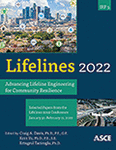Incorporating Infrastructure Damage and Household Disaster Preparedness to Assess Emergency Water Needs
Publication: Lifelines 2022
ABSTRACT
This paper introduces a framework to account for physical damage to infrastructure and household disaster preparedness in estimates of potable water needs after earthquakes. A case study is presented involving the water supply system to the city of San Francisco after a Mw=7.9 earthquake. Accounting for household preparedness helps identify regions in the city where water supply is interrupted, and many people may not have personal resources to access alternative sources of water. Considering both infrastructure disruption and household characteristics may inform decisions to allocate emergency water resources across the city during emergency response.
Get full access to this article
View all available purchase options and get full access to this chapter.
REFERENCES
AWWA (American Water Works Association). 2001. Emergency Planning for Water Utilities - Manual of Water Supply Practices, 4th Ed. Denver, CO: AWWA.
Brozović, N., D. L. Sunding, and D. Zilberman. 2007. “Estimating business and residential water supply interruption losses from catastrophic events.” Water Resour. Res. 43(8).
Cimellaro, G., A. Tinebra, C. Renschler, and M. Fragiadakis. 2016. “New resilience index for urban water distribution networks.” J. Struct. Eng. 142(8):C4015014.
DataSF (Office of the Chief Data Officer, City and County of San Francisco). 2020. “San Francisco Seismic Hazard Zones”. https://data.sfgov.org/City-Infrastructure/San-Francisco-Seismic-Hazard-Zones/7ahv-68ap.
EPA. 2011. Planning for an Emergency Drinking Water Supply, 1st Ed. Washington, DC: EPA.
FEMA. 2015. “Hazus–MH 2.1: Technical Manual.” Accessed May 15, 2019. https://www.fema.gov/media-library-data/20130726-1820-25045-6286/hzmh2_1_eq_tm.pdf.
Friedman, J., T. Hastie, and R. Tibshirani. 2001. The elements of statistical learning, volume 1. New York, NY: Springer.
Kameda, H. 2000. “Engineering management of lifeline systems under earthquake risk.” Bull. N.Z. Natl. Soc. Earthqu. Eng. 33(3), 248–264.
Levac, J., D. Toal-Sullivan, and T. L. OSullivan. 2012. “Household emergency preparedness: a literature review.” J. Community Health 37(3), 725–733.
McReynolds, L., and R. L. Simmons. 1995. “LA’s rehearsal for the big one.” J. Am. Water Works Assn. 87(5), 65–70.
Miller, A. C., and B. Arquilla. 2008. “Chronic diseases and natural hazards: impact of disasters on diabetic, renal, and cardiac patients.” Prehosp. Disaster Med. 23(2), 185–194.
Office of Drinking Water of Washington State Department of Environmental Public Health. 2017. State of the Regional Water System. Tumwater, WA.
Poole, M., et al. 2012. “Public information management in Christchurch following the February 2011 earthquake: Lessons learned.” Aust. J. Emerg. Manag. 27(4), 7.
Romero, N., T. O’Rourke, L. Nozick, and C. Davis. 2010. “Seismic hazards and water supply performance.” J. Earthquake Eng. 14(7), 1022–1043.
Schiff, A. J. 1995. Northridge earthquake: lifeline performance and post-earthquake response. ASCE, Reston, VA.
SFPUC (San Francisco Public Utilities Commission). 2017. City Distribution Division Earthquake Response Plan (2017). San Francisco, CA: SFPUC.
SFPUC (San Francisco Public Utilities Commission). 2016. State of the Regional Water System. San Francisco, CA: SFPUC.
Tabucchi, T., R. Davidson, and S. Brink. 2008. “Restoring the Los Angeles water supply system following an earthquake.” In 14th World conference on earthquake engineering, Beijing, China.
Tibshirani, R. 1996. “Regression shrinkage and selection via the lasso.” J. R. Stat. Soc.: Series B (Methodological) 58(1), 267–288.
Todini, E. 2000. “Looped water distribution networks design using a resilience index based heuristic approach.” Urban Water J. 2(2), 115–122.
US Census Bureau and Department of Housing and Urban Development. 2017. “2017 American Housing Survey Data.” Accessed May 06, 2020. https://www.census.gov/newsroom/press-releases/2018/ahs.html.
Zoback, M. L. 2006. “The 1906 earthquake and a century of progress in understanding earthquakes and their hazards.” GSA Today 16(4/5), 4.
Information & Authors
Information
Published In
History
Published online: Nov 16, 2022
Authors
Metrics & Citations
Metrics
Citations
Download citation
If you have the appropriate software installed, you can download article citation data to the citation manager of your choice. Simply select your manager software from the list below and click Download.
